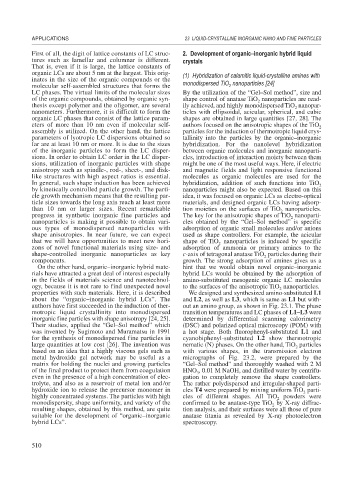Page 538 - Book Hosokawa Nanoparticle Technology Handbook
P. 538
APPLICATIONS 23 LIQUID-CRYSTALLINE INORGANIC NANO AND FINE PARTICLES
First of all, the digit of lattice constants of LC struc- 2. Development of organic–inorganic hybrid liquid
tures such as lamellar and columnar is different. crystals
That is, even if it is large, the lattice constants of
organic LCs are about 5 nm at the largest. This orig- (1) Hybridization of calamitic liquid-crystalline amines with
inates in the size of the organic compounds or the
molecular self-assembled structures that forms the monodispersed TiO nanoparticles [24]
2
LC phases. The virtual limits of the molecular sizes By the utilization of the “Gel–Sol method”, size and
of the organic compounds, obtained by organic syn- shape control of anatase TiO nanoparticles are read-
2
thesis except polymer and the oligomer, are several ily achieved, and highly monodispersed TiO nanopar-
2
nanometers. Furthermore, it is difficult to form the ticles with ellipsoidal, acicular, spherical, and cubic
organic LC phases that consist of the lattice param- shapes are obtained in large quantities [27, 28]. The
eters of more than 10 nm even if molecular self- authors focused on the anisotropic shapes of the TiO 2
assembly is utilized. On the other hand, the lattice particles for the induction of thermotropic liquid crys-
parameters of lyotropic LC dispersions obtained so tallinity into the particles by the organic–inorganic
far are at least 10 nm or more. It is due to the sizes hybridization. For the nanolevel hybridization
of the inorganic particles to form the LC disper- between organic molecules and inorganic nanoparti-
sions. In order to obtain LC order in the LC disper- cles, introduction of interaction moiety between them
sions, utilization of inorganic particles with shape might be one of the most useful ways. Here, if electric
anisotropy such as spindle-, rod-, sheet-, and disk- and magnetic fields and light responsive functional
like structures with high aspect ratios is essential. molecules as organic molecules are used for the
In general, such shape induction has been achieved hybridization, addition of such functions into TiO 2
by kinetically controlled particle growth. The parti- nanoparticles might also be expected. Based on this
cle growth mechanism means that the resulting par- idea, it was focused on organic LCs as electro-optical
ticle sizes towards the long axis reach at least more materials, and designed organic LCs having adsorp-
than 10 nm or larger sizes. Recent remarkable tion moieties on the surfaces of TiO nanoparticles.
2
progress in synthetic inorganic fine particles and The key for the anisotropic shapes of TiO nanoparti-
2
nanoparticles is making it possible to obtain vari- cles obtained by the “Gel–Sol method” is specific
ous types of monodispersed nanoparticles with adsorption of organic small molecules and/or anions
shape anisotropies. In near future, we can expect used as shape controllers. For example, the acicular
that we will have opportunities to meet new hori- shape of TiO nanoparticles is induced by specific
2
zons of novel functional materials using size- and adsorption of ammonia or primary amines to the
shape-controlled inorganic nanoparticles as key c-axis of tetragonal anatase TiO particles during their
2
components. growth. The strong adsorption of amines gives us a
On the other hand, organic–inorganic hybrid mate- hint that we would obtain novel organic–inorganic
rials have attracted a great deal of interest especially hybrid LCs would be obtained by the adsorption of
in the fields of materials science and nanotechnol- amino-substituted mesogenic organic LC molecules
ogy, because it is not rare to find unexpected novel to the surfaces of the anisotropic TiO nanoparticles.
2
properties with such materials. Here, it is described We designed and synthesized amino-substituted L1
about the “organic–inorganic hybrid LCs”. The and L2, as well as L3, which is same as L1 but with-
authors have first succeeded in the induction of ther- out an amino group, as shown in Fig. 23.1. The phase
motropic liquid crystallinity into monodispersed transition temperatures and LC phases of L1–L3 were
inorganic fine particles with shape anisotropy [24, 25]. determined by differential scanning calorimetry
Their studies, applied the “Gel–Sol method” which (DSC) and polarized optical microscopy (POM) with
was invented by Sugimoto and Muramatsu in 1991 a hot stage. Both fluorophenyl-substituted L1 and
for the synthesis of monodispersed fine particles in cyanobiphenyl-substituted L2 show thermotropic
large quantities at low cost [26]. The invention was nematic (N) phases. On the other hand, TiO particles
2
based on an idea that a highly viscous gels such as with various shapes, in the transmission electron
metal hydroxide gel network may be useful as a micrographs of Fig. 23.2, were prepared by the
matrix for holding the nuclei and growing particles “Gel–Sol method” and thoroughly washed with 2 M
of the final product to protect them from coagulation HNO , 0.01 M NaOH, and distilled water by centrifu-
3
even in the presence of a high concentration of elec- gation to completely remove the shape controllers.
trolyte, and also as a reservoir of metal ion and/or The rather polydispersed and irregular-shaped parti-
hydroxide ion to release the precursor monomer in cles T4 were prepared by mixing uniform TiO parti-
2
highly concentrated systems. The particles with high cles of different shapes. All TiO powders were
2
monodispersity, shape uniformity, and variety of the confirmed to be anatase-type TiO by X-ray diffrac-
2
resulting shapes, obtained by this method, are quite tion analysis, and their surfaces were all those of pure
suitable for the development of “organic–inorganic anatase titania as revealed by X-ray photoelectron
hybrid LCs”. spectroscopy.
510

